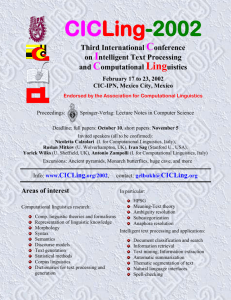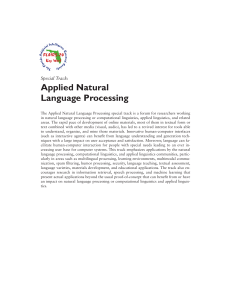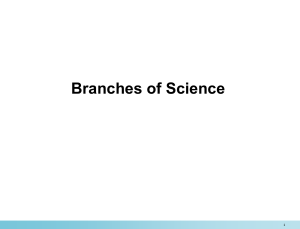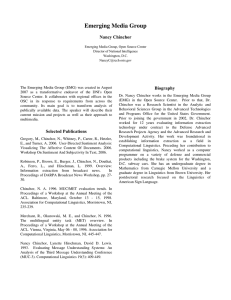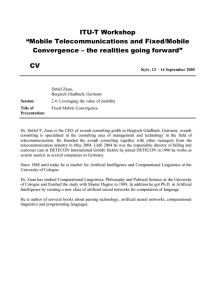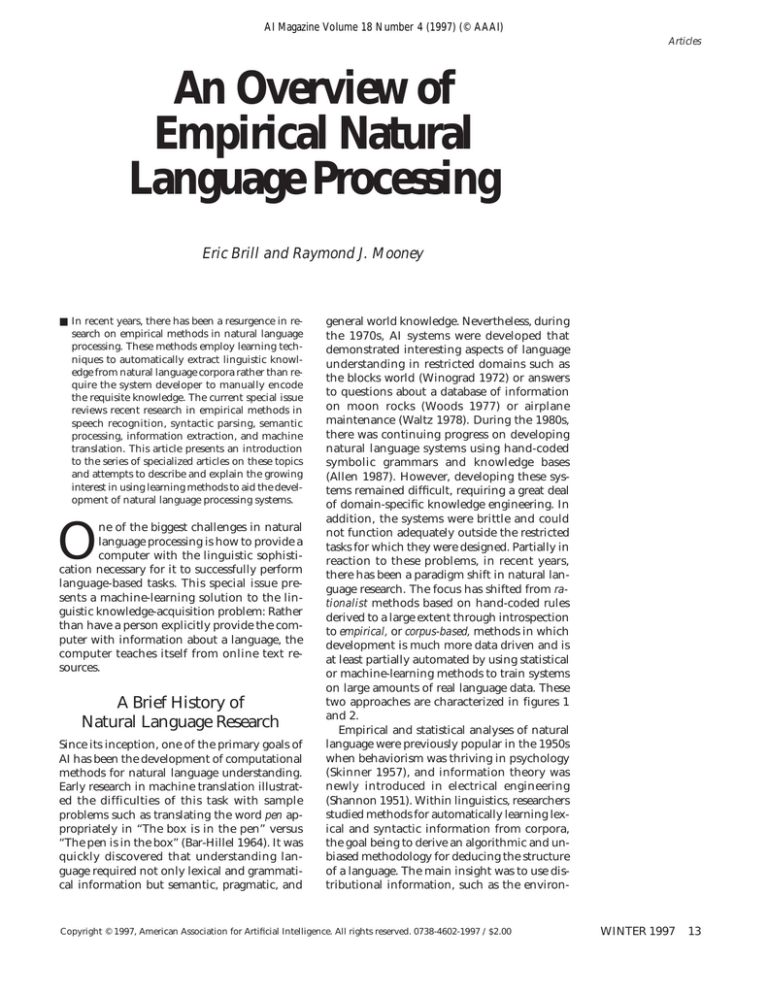
AI Magazine Volume 18 Number 4 (1997) (© AAAI)
Articles
An Overview of
Empirical Natural
Language Processing
Eric Brill and Raymond J. Mooney
■ In recent years, there has been a resurgence in research on empirical methods in natural language
processing. These methods employ learning techniques to automatically extract linguistic knowledge from natural language corpora rather than require the system developer to manually encode
the requisite knowledge. The current special issue
reviews recent research in empirical methods in
speech recognition, syntactic parsing, semantic
processing, information extraction, and machine
translation. This article presents an introduction
to the series of specialized articles on these topics
and attempts to describe and explain the growing
interest in using learning methods to aid the development of natural language processing systems.
O
ne of the biggest challenges in natural
language processing is how to provide a
computer with the linguistic sophistication necessary for it to successfully perform
language-based tasks. This special issue presents a machine-learning solution to the linguistic knowledge-acquisition problem: Rather
than have a person explicitly provide the computer with information about a language, the
computer teaches itself from online text resources.
A Brief History of
Natural Language Research
Since its inception, one of the primary goals of
AI has been the development of computational
methods for natural language understanding.
Early research in machine translation illustrated the difficulties of this task with sample
problems such as translating the word pen appropriately in “The box is in the pen” versus
“The pen is in the box” (Bar-Hillel 1964). It was
quickly discovered that understanding language required not only lexical and grammatical information but semantic, pragmatic, and
general world knowledge. Nevertheless, during
the 1970s, AI systems were developed that
demonstrated interesting aspects of language
understanding in restricted domains such as
the blocks world (Winograd 1972) or answers
to questions about a database of information
on moon rocks (Woods 1977) or airplane
maintenance (Waltz 1978). During the 1980s,
there was continuing progress on developing
natural language systems using hand-coded
symbolic grammars and knowledge bases
(Allen 1987). However, developing these systems remained difficult, requiring a great deal
of domain-specific knowledge engineering. In
addition, the systems were brittle and could
not function adequately outside the restricted
tasks for which they were designed. Partially in
reaction to these problems, in recent years,
there has been a paradigm shift in natural language research. The focus has shifted from rationalist methods based on hand-coded rules
derived to a large extent through introspection
to empirical, or corpus-based, methods in which
development is much more data driven and is
at least partially automated by using statistical
or machine-learning methods to train systems
on large amounts of real language data. These
two approaches are characterized in figures 1
and 2.
Empirical and statistical analyses of natural
language were previously popular in the 1950s
when behaviorism was thriving in psychology
(Skinner 1957), and information theory was
newly introduced in electrical engineering
(Shannon 1951). Within linguistics, researchers
studied methods for automatically learning lexical and syntactic information from corpora,
the goal being to derive an algorithmic and unbiased methodology for deducing the structure
of a language. The main insight was to use distributional information, such as the environ-
Copyright © 1997, American Association for Artificial Intelligence. All rights reserved. 0738-4602-1997 / $2.00
WINTER 1997
13
Articles
text
NLP
System
KB
analysis
Figure 1. Traditional (Rationalist) Natural Language Processing.
corpus
Learning
System
text
NLP
System
KB
analysis
Figure 2. Empirical Natural Language Processing.
ment a word can appear in, as the tool for language study. By clustering words and phrases
based on the similarity of their distributional
behavior, a great deal could be learned about a
language (for example, Kiss [1973], Stolz
[1965], Harris [1962], Chatman [1955], Harris
[1951], and Wells [1947]). Although the goal of
this research was primarily to gain insight into
the structure of different languages, this framework parallels that of modern empirical natural language processing: Given a collection of
naturally occurring sentences as input, algorithmically acquire useful linguistic information about the language.
Distributional linguistics research began to
wane after Chomsky’s (1959, 1957) influential
work dramatically redefined the goals of linguistics. First, Chomsky made the point that a
14
AI MAGAZINE
linguist should not merely be descriptive, discovering morphological, lexical, and syntactic
rules for a language, but should turn instead to
what he saw as more interesting problems,
such as how language is learned by children
and what features all languages share in common. These phenomena are far from surface
apparent and, therefore, not amenable to a
shallow corpus-based study. Second, Chomsky
argued against the learnability of language
from data, believing that most of language is
innate and not learned. Over the years, Chomsky and other generative linguists have uncovered many subtle facts about language that
people seem to know somehow and yet that
seemingly could not have been learned because of the paucity of data. As researchers discovered that language is much more complex
Articles
than was previously thought and as learning
the complexities of language from data began
to appear hopeless, much of the work on corpus-based–language learning was halted.
Chomsky’s development of generative linguistics and his critique of existing empirical approaches to language quickly shifted the focus
to alternative rationalist methods, with their
emphasis on symbolic grammars and innate
linguistic knowledge, that is, universal grammar. Early AI research in natural language processing adopted this rationalist approach in
the sense that it used rule-based representations of grammars and knowledge that were
hand coded by the system developer instead of
being learned from data.
In the early 1980s, there was some work in
automatic induction of lexical and syntactic
information from text, based largely on two
widely available annotated corpora: the Brown
corpus (Marcus, Santorini, and Marcinkiewicz
1993a) and the Lancaster-Oslo–Bergen corpus
(Garside, Leech, and Sampson 1987). Empiricism then spread rapidly throughout the natural language–processing community to a
large extent the result of seminal research in
speech recognition (Waibel and Lee 1990).
Like other natural language research of the
time, speech research in the 1970s focused on
rationalist knowledge-based methods (Klatt
1977; Reddy 1976). However, during the
1980s, research originating at IBM Yorktown
resulted in statistical (stochastic) methods
based on hidden Markov models (HMMs) that
outperformed previous knowledge-based approaches (Rabiner 1989; Bahl, Jelinek, and
Mercer 1983). These methods use a probabilistic finite-state machine to model the pronunciation of words and utilize a hill-climbing
training algorithm to fit the model parameters
to actual speech data. Most current commercial speech-recognition systems use HMMs.
Starting in the late 1980s, the success of statistical methods in speech spread to other areas
of natural language processing (Charniak
1993). Much of the initial success came from
using the noisy-channel model (figure 3), an
approach that had proven highly successful in
speech recognition. Basically, the model assumes that language is generated and then
passed through a noisy channel, and the resulting noisy data are received. The goal then
is to recover the original data from the noisy
data. It is fascinating that this simple model
has been used successfully in areas of language
processing as disparate as spelling correction
and machine translation.
One of the first successes of corpus-based
learning was in part-of-speech (POS) tagging,
How is the weather?
How is
teh whether?
Figure 3. The Noisy-Channel Model.
that is, assigning an appropriate lexical syntactic class (for example, noun, verb, article) to
each of the words in a sentence (Merialdo
1994; Church 1988; Bahl and Mercer 1976). A
number of techniques can now perform this
task at an accuracy close to human performance (>95%), and it is a useful preprocessing
step in other tasks such as parsing, speech synthesis, and information retrieval. Another early influential result was that achieved by a statistical approach to machine translation
trained and tested on bilingual proceedings of
the Canadian parliament (Brown et al. 1990).
With the development of tree banks, large databases of sentences annotated with syntactic
parse trees (Marcus, Santorini, and Marcinkiewicz 1993b), came an increasing body of
research on empirical parsing methods, for example, probabilistic context-free grammars
(PCFGs) (Charniak 1996; Collins 1996; Pereira
and Shabes 1992; Lari and Young 1990b). Research on empirical methods is now thriving
in a variety of other areas as well, such as wordsense disambiguation (Ng and Lee 1996; Gale,
Church, and Yarowsky 1992), prepositional
phrase attachment (Hindle and Rooth 1993),
semantic analysis (Miller et al. 1997; Zelle and
Mooney 1996), anaphora (for example, pronoun) resolution (Aone and Bennett 1995;
Cardie 1992), and discourse segmentation (Litman 1996).
In recent years, there have been numerous
specialized workshops on issues relating to empirical natural language processing held in coordination with the National Conference on
Artificial Intelligence (AAAI-92), the International Joint Conference on Artificial Intelli-
WINTER 1997 15
Articles
gence (IJCAI-91, IJCAI-95), the AAAI Fall Symposia (1992), the Annual Meeting of the Association for Computational Linguistics (ACL93–ACL-96), and the International Conference
on Computational Linguistics (COLING-96),
among others. Last year, the First Conference
on Empirical Natural Language Processing
(EMNLP-96) was held at the University of
Pennsylvania (Brill and Church 1996), and the
second EMNLP conference was recently held
in coordination with AAAI-97. There are also
two relevant special interest groups of the Association for Computational Linguistics: (1)
the Special Interest Group on Linguistic Data
(SIGDAT): www.cs.jhu.edu/˜yarowsky/sigdat.
html) and (2) the Special Interest Group on
Natural Language Learning (SIGNLL): www.cs.
unimaas.nl/signll/.
A final
influential
change
is the
desire to
move
beyond
toy
domains
and
systems
to more
realistic
applications
and
products.
16
AI MAGAZINE
Reasons for the Resurgence
of Empiricism
The recent dramatic increase in empirical research has been attributed to various causes.
Armstrong-Warwick (1993) mentions that empirical methods offer potential solutions to several related, long-standing problems in natural
language processing such as (1) acquisition, automatically identifying and coding all the necessary knowledge; (2) coverage, accounting for
all the phenomena in a given domain or application; (3) robustness, accommodating real data
that contain noise and aspects not accounted
for by the underlying model; and (4) extensibility, easily extending or porting a system to a
new set of data or a new task or domain.
Automated learning and training techniques allow much of the relevant knowledge
to be acquired directly from data rather than
laboriously hand coded. If the training data are
extensive and represent all the relevant phenomena, empirical methods, which attempt to
optimize performance over the complete training set, can help ensure adequate coverage.
Unlike symbolic methods that use hard constraints, statistical methods can produce a
probability estimate for each analysis, thereby
ranking all possible alternatives. This more
flexible approach can improve robustness by
accommodating noise and always allowing the
selection of a preferred analysis even when the
underlying model is inadequate.1 Finally, because empirical methods allow for automatic
retraining on additional data or data from a
different distribution or a new domain, they
can also help improve extensibility.
In addition, Church and Mercer (1993)
mention three recent developments that they
believe have spurred the resurgence in empiri-
cism: (1) computing resources, the availability of
relatively inexpensive workstations with sufficient processing and memory resources to analyze large amounts of data; (2) data resources,
the development and availability of large corpora of linguistic and lexical data for training
and testing systems; and (3) emphasis on applications and evaluation, industrial and government focus on the development of practical
systems that are experimentally evaluated on
real data.
Because empirical methods generally require
computationally expensive training and testing on large amounts of data, adequate computing resources are needed to support such research. Recently, sufficient computing
resources have become available to most researchers. Another requirement of empirical
approaches is sufficient linguistic data. For
many methods, data also require human annotation with, for example, syntactic tags,
parse trees, or word senses. Recently, a number
of large corpora have been assembled, appropriately annotated, and made available to the
research community. Much of these data are
available through organizations such as the
Linguistic Data Consortium (LDC) (www.
ldc.upenn.edu). Two examples of widely used
resources are the Penn tree bank (Marcus, Santorini, and Marcinkiewicz 1993b), which
among its data contains syntactic parses for
about 40,000 sentences from the Wall Street
Journal, and WORDNET (Miller 1991) (www.co
gsci.princeton.edu/˜wn), an English lexical
database with word senses linked by kind-of,
part-of, and other semantic relations.
A final influential change is the desire to
move beyond toy domains and systems to
more realistic applications and products. Most
industrial research labs have shifted their emphasis from basic to applied research, and government funding agencies have been emphasizing applications and evaluation. The
Defense Advanced Research Projects Agency
(DARPA) airline travel information system
(ATIS) speech program and TIPSTER text program (tipster.org) (including message-understanding conference [MUC]) [Lehnert and
Sundheim 1991] and text-retrieval conference
[TREC]) were particularly influential in shifting
the focus to competitive evaluation of systems
on realistic data. These programs developed
significant collections of annotated data for
testing natural language systems. Because empirical methods can exploit such data for training purposes and thereby automatically tune
performance to the given task, they offer a potential advantage in developing competitive
systems for such programs. Also, the ability of
Articles
empirical methods to quickly develop fairly robust systems that optimize particular numeric
criteria for evaluating parsing or retrieval accuracy also give them an edge in such a resultdriven environment.
Categories of
Empirical Methods
Most of the recent work in empirical natural
language processing has involved statistical
training techniques for probabilistic models
such as HMMs and PCFGs (Charniak 1993).
These methods attach probabilities to the transitions of a finite-state machine or the productions of a formal grammar and estimate these
probabilistic parameters based on training data. If the training set is preannotated with the
structure being learned, learning consists simply of counting various observed events in the
training data. If the corpus is not annotated,
an estimation-maximization strategy could be
used (for example, the forward-backward algorithm for Markov models and the inside-outside algorithm for PCFGs (Baum 1972; Lari and
Young 1990a). Novel test examples are then
analyzed by determining the most-probable
path through the learned automaton or derivation from the learned grammar that generates
the given string. Other empirical methods
gather and use other statistics such as the frequency of each n-word sequence (n-gram) appearing in the language.
However, not all empirical methods use
probabilistic models. In the 1970s and early
1980s, there were a number of research projects on learning symbolic grammars and
parsers for natural language (Berwick 1985;
Langley and Carbonell 1985; Anderson 1977;
Reeker 1976). Although the resulting systems
demonstrated some interesting principles,
they were only tested on small sets of artificial
data and never had a major impact on mainstream computational linguistics. Although
the current resurgence in empiricism has primarily involved probabilistic methods, symbolic learning techniques are also fairly well
represented. Of course, all learning methods
are statistical in the sense that they make inductive generalizations from data, and the
accuracy of these generalizations can be analyzed using the theory of probability and statistics (Kearns and Vazirani 1994); however,
nonprobabilistic methods do not explicitly use
probabilities in the representation of learned
knowledge. Symbolic learning methods that
have been used in recent natural language–
processing research include transformationalrule induction (Brill 1995, 1993), decision tree
induction (Hermjakob and Mooney 1997; Litman 1996; Aone and Bennett 1995), inductive
logic programming (Zelle and Mooney 1996),
explanation-based learning (Samuelsson and
Rayner 1991; Mooney and DeJong 1985), and
exemplar (case-based) methods (Ng and Lee
1996; Cardie 1993). These systems automatically acquire knowledge in some form of rules
or simply remember specific past examples
and make decisions based on similarity to
these stored instances.
A claimed advantage of symbolic methods is
that the learned knowledge is more perspicuous and interpretable by humans compared to
large matrixes of probabilities. Therefore, symbolic methods could provide more insight into
the language-understanding process and allow
developers to more easily understand, manipulate, and debug the resulting system. A
claimed advantage of probabilistic methods is
that they provide a continuous ranking of alternative analyses rather than just a single output, and such rankings can productively increase the bandwidth between components of
a modular system. For example, if a POS tagger
provides nonzero probabilities for several tags
(for example, noun: 0.9, verb: 0.08), then a
subsequent probabilistic parser can use these
probabilities when weighing decisions about
phrasal and sentential structure. Evidence
from the parser can confirm the tagger’s most
probable label (for example, confirm the noun
interpretation) or overrule it based on stronger
evidence from the larger grammatical context
(for example, switch to the initially less likely
verb interpretation to form a more coherent
parse of the complete sentence).
Another major style of empirical methods is
neural network, or connectionist. When neural nets were originally popular in the 1950s,
most of the research concerned visual pattern
recognition, and language learning was not
well represented. However, with the revival of
neural nets in the 1980s, applications to language were visible. For example, four of the six
chapters in the Psychological Processes section
of the Rumelhart and McClelland (1986b) parallel distributed processing volumes (an influential early publication in the resurgence of
neural nets) concern models of language processing, specifically, speech, reading, morphology, and sentence analysis. Since then, there
has been a range of research on training neural
networks to perform various language-processing tasks (Miikkulainen 1993; Reilly and
Sharkey 1992). Several neural net methods
have successfully been applied to speech recognition (Lippman 1989) and the conversion of
text to speech (Sejnowski and Rosenberg
Most of the
recent work
in empirical
natural
language
processing
has involved
statistical
training
techniques
for
probabilistic
models
such as
HMMs
and
PCFGs.
WINTER 1997 17
Articles
Speech
Signal
Speech
Recognizer
Semantic
Analyzer
Word
Sequence
Syntactic
Parser
Literal
Meaning
Discourse
Analyzer
Parse
Tree
Meaning
Figure 4. Components of a Natural Language–Processing System.
1987). Other well-studied tasks include the
generation of the past tense of English verbs
(Plunkett and Marchman 1993; MacWhinney
and Leinbach 1991; Rumelhart and McClelland 1986a) and case-role analyses of sentences (Miikkulainen 1996; St. John and McClelland 1990; McClelland and Kawamoto
1986). Typically, neural network research in
natural language focuses more on modeling
particular psychological or biological phenomena than on producing practical and effective
natural language–processing systems. For example, one issue has been modeling the Ushaped learning curve in children’s acquisition
of English morphology, which refers to the observation that irregulars are first learned correctly, then overregularized, and then finally
recorrected. For example, a child uses went,
then goed, then returns to went. Because we do
not attempt to cover cognitive-modeling aspects of empirical natural language processing
in this special issue, neural network research is
not reviewed in detail.
A different dimension along which empirical methods vary concerns the type of training
data required. Many systems use supervised
methods and require annotated text in which
human supervisors have labeled words with
parts of speech or semantic senses or have annotated sentences with syntactic parses or semantic representations. Other systems employ
unsupervised methods and use raw, unannotated text. Unsupervised learning is generally
more difficult and requires some method for
acquiring feedback indirectly, such as assuming that all sentences encountered in texts are
positive examples of grammatical sentences in
the language. Because annotating corpora is a
18
AI MAGAZINE
difficult, time-consuming task, ideally, unsupervised training is preferable. However, the
explicit, detailed feedback provided by supervised training generally results in improved
performance (Merialdo 1994; Pereira and
Shabes 1992).
Finally, it is important to note that traditional rationalist approaches and empirical methods are not incompatible or incommensurate
(Klavans and Resnik 1996). Many empirical systems, particularly those using symbolic methods, exploit traditional representations and algorithms and simply replace handcrafted rules
with knowledge automatically extracted from
data. A number of empirical parsing methods
use a fairly standard shift-reduce framework in
which parsing operators construct and manipulate constituents stored in a stack (Miikkulainen 1996; Magerman 1995; Zelle and
Mooney 1994; Simmons and Yu 1992). Several
empirical information-extraction systems simply replace the hand-coded rules and patterns
of an existing symbolic system with ones automatically acquired from examples (Soderland
and Lehnert 1994; Riloff 1993). Even probabilistic approaches typically divide the understanding process into traditional subtasks, such
as maintaining separate syntactic, semantic,
and discourse modules with the standard input
and output, but with the addition that multiple
interpretations are maintained and each assigned a probability (Miller et al. 1996). Integrating the important linguistic insights and
rich representations of rationalist approaches
with the previously discussed advantages of
empirical methods is an important problem
that is attracting increasing attention.
Articles
Categories of Language Tasks
Understanding natural language is a complex
task and involves many levels of processing
and a variety of subtasks. The articles in this
collection divide the field of natural language
processing as follows: speech recognition and
spoken-language analysis, syntactic analysis,
semantic analysis, discourse analysis and information extraction, and machine translation.
Figure 4 illustrates the first four as components
of an overall language-understanding system.
Speech Recognition
Speech recognition concerns mapping a
continuous speech signal into a sequence of
recognized words. The problem is difficult because of the wide variation in the exact pronunciation of words spoken by different speakers in different contexts. Other problems
include homonyms (for example, pair, pear,
pare), other forms of acoustic ambiguity (for
example, youth in Asia and euthanasia), and the
slurring of words (for example, didja) that happens in continuous speech.
In the article “Linguistic Knowledge and
Empirical Methods in Speech Recognition,”
Andreas Stolcke presents an overview of the
current state of the art in speech recognition.
Speech recognition has gained great momentum recently, with many commercial products
currently available and research systems rapidly becoming more accurate and robust. Stolcke
describes some of these emerging systems and
presents the technology that is used in virtually all modern speech-recognition systems. In
Miller and Chomsky (1963), arguments were
presented against the adequacy of Markov
models for natural language. For example, no
Markov model would be adequate to capture
all long-distance dependencies. In the sentence “the boy eats,” a bigram model (a model
where the state remembers the one previous
word) would be sufficient to model the relationship between boy and eats. However, these
words can be arbitrarily far apart, as in “The
boy on the hill by the lake in our town . . .
eats.” Although some recent work has been
done to create sophisticated models of language able to handle such dependencies, interestingly the bigram and trigram (a model based
on a two-word history) are the underlying
models of language used in virtually all current
speech systems and have proven extremely effective despite their obvious deficiencies.
Syntactic Analysis
Syntactic analysis involves determining the
grammatical structure of a sentence, that is,
how the words are grouped into constituents
such as noun phrases and verb phrases. A subtask of syntactic analysis is assigning a part of
speech to each word, such as determining that
saw acts as a noun in “John bought a saw” and
as a verb in “John saw the movie.” Another
problem of ambiguity in syntactic analysis is
attachment, such as determining in the sentence “John saw the man on the hill” whether
on the hill modifies the man or the seeing
event. Such ambiguity has a tendency to explode combinatorially. A sentence ending in n
prepositional phrases such as “on the hill” or
“with a telescope” has at least 2n syntactic
analyses depending on how these phrases are
attached (Church and Patil 1982). However,
because of syntactic and semantic preferences
and constraints, people rarely notice this rampant ambiguity and usually quickly settle on
an interpretation based on context.
In “Statistical Techniques for Natural Language Parsing,” Eugene Charniak presents an
overview of current work in machine learning
of syntactic information. There have recently
been great improvements in such systems,
which can be attributed to two things: (1) publicly available tree banks and (2) grammar lexicalization. The Penn tree bank has released a
corpus of 50,000 sentences that have carefully
been annotated for syntactic structure by
hand. This is a great resource for training and
also provides the research community with the
ability to readily assess the quality of their programs because researchers can train and test on
the exact same sentences. PCFGs have been
around for a long time. However, they have
one big weakness as a tool for modeling language. Given a PCFG, the probability of a particular parse for a sentence is the product of
the probability of all rules used to generate the
parse. Given the two sentences along with
their parses shown in figure 5, assuming flew
and knew are equally likely as verbs, the PCFG
would assign equal probability to these two
sentences because they differ in how they were
generated only by one rule (VP → flew versus
VP → knew).
The insight that has led to vast improvements in parsing is that by lexicalizing the
grammar, much more meaningful statistics
can be obtained. For example, a lexicalized
parse is shown in figure 6. The idea is that all
nodes in the tree contain information about
the words in the sentence, not just the nodes
immediately above words. In the nonlexicalized parses of figure 5, an S node is expanded
into an NP node and a VP node. In a lexicalized parse such as that in figure 6, an S node
expands into an airplane NP node and a flew
VP node. Because the probability of S → NP :
WINTER 1997 19
Articles
S
S
NP
VP
The airplane
flew
NP
The
airplane
VP
knew
Figure 5. Unlexicalized Parses.
S:flew
NP:airplane
The
VP:flew
airplane
flew
Figure 6. A Lexicalized Parse.
airplane VP : flew will be greater than that of S
→ NP : airplane VP : knew (airplanes fly, they
don’t know), the grammar will now give higher probability to the more likely sentence.
Semantic Analysis
Semantic analysis involves mapping a sentence
to some sort of meaning representation, for example, a logical expression. In “Corpus-Based
Approaches to Semantic Interpretation in Natural Language Processing,” Hwee Tou Ng and
John Zelle describe recent empirical work on
two important subtasks of semantic analysis:
(1) word-sense disambiguation and (2) semantic parsing. Word-sense disambiguation roughly
means deciding which of the possible meanings for a word is correct in a particular context. A classic example is determining whether
pen refers to a writing instrument or an enclosure in a particular sentence such as “John
wrote the letter with a pen” or “John saw the
pig in the pen.” This step is vital for natural
language understanding. It is also important
for machine translation, where different senses
of a word in one language are translated differently. In speech synthesis, one needs to know
20
AI MAGAZINE
the sense of certain words to determine the
correct pronunciation (for example, bass guitar
versus bass fishing).
Part of semantic parsing involves producing
a case-role analysis, in which the semantic roles
of the entities referred to in a sentence, such as
agent and instrument, are identified. When
building a natural language front end to a
database, the ability to map a sentence to a formal query language, such as Prolog or SQL, is
particularly useful. Activity in semantic parsing has been stimulated recently, in part because of various DARPA-sponsored projects. In
one particular project, ATIS, the goal is to convert sentences uttered to a travel agent into SQL
queries that can then be used to automatically
retrieve the desired information.
Discourse Analysis and
Information Extraction
Claire Cardie’s article, “Empirical Methods in
Information Extraction,” describes recent work
in discourse analysis. Discourse analysis involves determining how larger intersentential
context influences the interpretation of a sentence. Her article covers two important sub-
Articles
English
French
English
German
French
Japanese
INTERLINGUA
DIRECT
Figure 7. Two Approaches to Machine Translation.
tasks in discourse analysis: (1) coreference resolution and (2) information extraction. Coreference resolution is the task of determining what
phrases in a document refer to the same thing.
One aspect of this problem is pronoun resolution. For example, in the sentence “John wanted a copy of Netscape to run on his PC on the
desk in his den; fortunately, his ISP included it
in their startup package,” a pronoun-resolution algorithm would have to determine that
it refers to a copy of Netscape rather than PC,
desk, or den. More generally, to do successful
text analysis and understanding, one needs to
identify all noun phrases that corefer within a
discourse. For example, in the sentence “Ford
bought 100 acres outside Nashville; the company will use the land to build a factory,” it
must be determined that Ford and the company
corefer, as do 100 acres and the land.
Information extraction is the task of locating
specific pieces of data from a natural language
document and has been the focus of DARPA’s
MUC program (DARPA 1993; Lehnert and
Sundheim 1991). For example, consider analyzing a message from the newsgroup
misc.jobs.offered to extract the employer’s
name, the location, the type of job, the years
of experience required, and so on. The information extracted from a collection of messages
could then be stored in a database with fields
for each of these slots. Typically, text is first linguistically annotated, and then extraction
rules are used to map from annotated text to
slot filling. Until recently, these rules were
written by hand. By using machine-learning
techniques, extraction rules can be learned automatically and achieve performance close to
the best manually constructed systems.
Machine Translation
Machine translation involves translating text
from one natural language to another, such as
translating English to Japanese, or vice versa.
One approach uses simple word substitution
with some changes in ordering to account for
grammatical differences; another is to translate
the source language into an underlying meaning representation, or interlingua, and then
generate the target language from this internal
representation. By taking two tightly coupled
corpora such as translated books, or loosely
coupled corpora such as two stories about the
same topic and in different languages, and
aligning these corpora to determine which
words in one language correspond with which
words in the other, a great deal can be learned
automatically about word-to-word translations
and the relationships between syntactic structures in the two languages (figure 7). Kevin
Knight’s article “Automating Knowledge Acquisition for Machine Translation” describes
recent corpus-based approaches to automatic
training of machine-translation programs.
WINTER 1997 21
Articles
Conclusion
One of the biggest challenges in natural language processing is overcoming the linguistic
knowledge-acquisition bottleneck: providing
the machine with the linguistic sophistication
necessary to perform robust, large-scale natural
language processing. Until recently, the only
method was to manually encode this linguistic
knowledge. Because of the apparent immense
complexity of human language, this task has
proved to be difficult. Recently, a number of
exciting results have shown the feasibility of
learning linguistic knowledge automatically
from large text corpora. The effectiveness of
this approach has been demonstrated across
the spectrum of natural language–processing
tasks, from low-level tasks such as part-ofspeech tagging, word-sense disambiguation,
and parsing to high-level tasks such as speech
recognition, machine translation, and information extraction. The need for robust language technology is rapidly growing. As computers become ubiquitous in our society,
natural language and speech interfaces can
make the power of these machines accessible
to everybody. With the explosion of online
text, being able to effectively sift through these
data and extract important facts from them becomes more and more crucial to our productivity. Companies have to rapidly produce reports and manuals in many languages.
Hopefully, with the continued development of
powerful learning algorithms, faster computers, and ever-growing amounts of online text
for training, empirical methods can provide
the means to overcome the linguistic knowledge-acquisition bottleneck and make advanced language processing a reality. We hope
the articles in this special issue will give the
reader an enjoyable sampling of this exciting
field.
Acknowledgments
The preparation of the article was partially
supported by the National Science Foundation
through grants IRI-9310819 to Mooney and
IRI-9502312 to Brill. We are grateful to the authors who contributed articles to this special
issue.
Notes
1. An ordered set of learned rules can also be utilized
to ensure a preferred analysis (Brill 1995).
References
22
AI MAGAZINE
Aone, C., and Bennett, S. W. 1995. Evaluating Automated and Manual Acquisition of Anaphora Resolution Strategies. In Proceedings of the Thirty-Third
Annual Meeting of the Association for Computational Linguistics, 122–129. Somerset, N.J.: Association for Computational Linguistics.
Armstrong-Warwick, S. 1993. Preface. Computational
Linguistics 19(1): iii–iv.
Bahl, L. R., and Mercer, R. L. 1976. Part-of-Speech Assignment by a Statistical Decision Algorithm. In Abstracts of Papers from the IEEE International Symposium on Information Theory, 88–89. Washington,
D.C.: IEEE Computer Society.
Bahl, L. R.; Jelinek, F.; and Mercer, R. 1983. A Maximum-Likelihood Approach to Continuous Speech
Recognition. IEEE Transactions on Pattern Analysis
and Machine Intelligence 5(2): 179–190.
Bar-Hillel, Y. 1964. Language and Information. Reading, Mass.: Addison-Wesley.
Baum, L. 1972. An Inequality and Associated Maximization Technique in Statistical Estimation for
Probabilistic Functions of a Markov Process. Inequalities 3:1–8.
Berwick, B. 1985. The Acquisition of Syntactic Knowledge. Cambridge, Mass.: MIT Press.
Brill, E. 1995. Transformation-Based Error-Driven
Learning and Natural Language Processing: A Case
Study in Part-of-Speech Tagging. Computational Linguistics 21(4): 543–565.
Brill, E. 1993. Automatic Grammar Induction and
Parsing Free Text: A Transformation-Based Approach. In Proceedings of the Thirty-First Annual
Meeting of the Association for Computational Linguistics, 259–265. Somerset, N.J.: Association for
Computational Linguistics.
Brill, E., and Church, K., eds. 1996. Paper presented
at the Conference on Empirical Methods in Natural
Language Processing, 17–18 May, University of
Pennsylvania.
Brown, P.; Cocke, J.; Della Pietra, S.; Della Pietra, V.;
Jelinek, F.; Lafferty, J.; Mercer, R.; and Roossin, P.
1990. A Statistical Approach to Machine Translation.
Computational Linguistics 16(2): 79–85.
Cardie, C. 1993. A Case-Based Approach to Knowledge Acquisition for Domain-Specific Sentence
Analysis. In Proceedings of the Eleventh National
Conference on Artificial Intelligence, 798–803. Menlo Park, Calif.: American Association for Artificial Intelligence.
Cardie, C. 1992. Learning to Disambiguate Relative
Pronouns. In Proceedings of the Tenth National
Conference on Artificial Intelligence, 38–43. Menlo
Park, Calif.: American Association for Artificial Intelligence.
Charniak, E. 1996. Tree-Bank Grammars. In Proceedings of the Thirteenth National Conference on Artificial Intelligence, 1031–1036. Menlo Park, Calif.:
American Association for Artificial Intelligence.
Allen, J. F. 1987. Natural Language Understanding.
Menlo Park, Calif.: Benjamin/Cummings.
Charniak, E. 1993. Statistical Language Learning.
Cambridge, Mass.: MIT Press.
Anderson, J. R. 1977. Induction of Augmented Transition Networks. Cognitive Science 1:125–157.
Chatman, S. 1955. Immediate Constituents and Expansion Analysis. Word 11.
Articles
Chomsky, N. 1959. Review of Skinner’s Verbal Behavior. Language 35:26–58.
Outside Algorithm. Computer Speech and Language
4:35–56.
Chomsky, N. 1957. Syntactic Structures. The Hague,
The Netherlands: Mouton.
Lehnert, W., and Sundheim, B. 1991. A Performance
Evaluation of Text-Analysis Technologies. AI Magazine 12(3): 81–94.
Church, K. 1988. A Stochastic Parts Program and
Noun Phrase Parser for Unrestricted Text. In Proceedings of the Second Conference on Applied Natural
Language Processing, 136–143. Somerset, N.J.: Association for Computational Linguistics.
Church, K., and Mercer, R. L. 1993. Introduction to
the Special Issue on Computational Linguistics Using Large Corpora. Computational Linguistics 19(1):
1–24.
Church, K., and Patil, R. 1982. Coping with Syntactic
Ambiguity or How to Put the Block in the Box on the
Table. American Journal of Computational Linguistics
8(3–4): 139–149.
Collins, M. J. 1996. A New Statistical Parser Based on
Bigram Lexical Dependencies. In Proceedings of the
Thirty-Fourth Annual Meeting of the Association for
Computational Linguistics, 184–191. Somerset, N.J.:
Association for Computational Linguistics.
DARPA. 1993. Proceedings of the Fifth DARPA MessageUnderstanding Evaluation and Conference. San Francisco, Calif.: Morgan Kaufman.
Gale, W.; Church, K.; and Yarowsky, D. 1992. A
Method for Disambiguating Word Senses in a Large
Corpus. Computers and the Humanities 26:415–439.
Garside, R.; Leech, G.; and Sampson, G. 1987. The
Computational Analysis of English: A Corpus-Based Approach. London: Longman.
Harris, Z. 1962. String Analysis of Language Structure.
The Hague, The Netherlands.: Mouton.
Harris, Z. 1951. Structural Linguistics. Chicago: University of Chicago Press.
Hermjakob, U., and Mooney, R. J. 1997. Learning
Parse and Translation Decisions from Examples with
Rich Context. In Proceedings of the Thirty-Fifth Annual Meeting of the Association for Computational
Linguistics, 482–489. Somerset, N.J.: Association for
Computational Linguistics.
Hindle, D., and Rooth, M. 1993. Structural Ambiguity and Lexical Relations. Computational Linguistics
19(1): 103–120.
Kearns, M. J., and Vazirani, U. V. 1994. An Introduction to Computational Learning Theory. Cambridge,
Mass.: MIT Press.
Kiss, G. 1973. Grammatical Word Classes: A Learning Process and Its Simulation. Psychology of Learning
and Motivation 7.
Klatt, D. H. 1977. Review of the ARPA Speech-Understanding Project. The Journal of the Acoustical Society
of America 62(6): 1324–1366.
Klavans, J., and Resnik, P., eds. 1996. The Balancing
Act: Combining Symbolic and Statistical Approaches to
Language. Cambridge, Mass.: MIT Press.
Langley, P., and Carbonell, J. 1985. Language Acquisition and Machine Learning. In Mechanisms of Language Acquisition, ed. B. MacWhinney, 115–155.
Hillsdale, N.J.: Lawrence Erlbaum.
Lari, K., and Young, S. J. 1990. The Estimation of Stochastic Context-Free Grammars Using the Inside-
Lippman, R. P. 1989. Review of Research on Neural
Nets for Speech. Neural Computation 1(1).
Litman, D. J. 1996. Cue Phrase Classification Using
Machine Learning. Journal of Artificial Intelligence Research 5:53–95.
McClelland, J. L., and Kawamoto, A. H. 1986. Mechanisms of Sentence Processing: Assigning Roles to
Constituents of Sentences. In Parallel Distributed Processing, Volume 2, eds. D. E. Rumelhart and J. L. McClelland, 318–362. Cambridge, Mass.: MIT Press.
MacWhinney, B., and Leinbach, J. 1991. Implementations Are Not Conceptualizations: Revising the
Verb Model. Cognition 40:291–296.
Magerman, D. M. 1995. Statistical Decision Tree
Models for Parsing. In Proceedings of the ThirtyThird Annual Meeting of the Association for Computational Linguistics, 276–283. Somerset, N.J.: Association for Computational Linguistics.
Marcus, M.; Santorini, B.; and Marcinkiewicz, M.
1993. Building a Large Annotated Corpus of English:
The Penn Tree Bank. Computational Linguistics 19(2):
313–330.
Merialdo, B. 1994. Tagging English Text with a Probabilistic Model. Computational Linguistics 20(2):
155–172.
Miikkulainen, R. 1996. Subsymbolic Case-Role
Analysis of Sentences with Embedded Clauses. Cognitive Science 20(1): 47–73.
Miikkulainen, R. 1993. Subsymbolic Natural Language
Processing: An Integrated Model of Scripts, Lexicon, and
Memory. Cambridge, Mass.: MIT Press.
Miller, G. 1991. WORDNET: An Online Lexical Database. International Journal of Lexicography 3(4).
Miller, G., and Chomsky, N. 1963. Finitary Models of
Language Users. New York: Wiley.
Miller, S.; Stallard, D.; Bobrow, R.; and Schwartz, R.
1996. A Fully Statistical Approach to Natural Language Interfaces. In Proceedings of the Thirty-Fourth
Annual Meeting of the Association for Computational Linguistics, 55–61. Somerset, N.J.: Association
for Computational Linguistics.
Mooney, R. J., and DeJong, G. F. 1985. Learning
Schemata for Natural Language Processing. In Proceedings of the Ninth International Joint Conference on Artificial Intelligence, 681–687. Menlo Park,
Calif.: International Joint Conferences on Artificial
Intelligence.
Ng, H. T., and Lee, H. B. 1996. Integrating Multiple
Knowledge Sources to Disambiguate Word Sense: An
Exemplar-Based Approach. In Proceedings of the
Thirty-Fourth Annual Meeting of the Association for
Computational Linguistics, 40–47. Somerset, N.J.:
Association for Computational Linguistics.
Pereira, F., and Shabes, Y. 1992. Inside-Outside Reestimation from Partially Bracketed Corpora. In Proceedings of the Thirtieth Annual Meeting of the Association for Computational Linguistics, 128–135.
WINTER 1997 23
Articles
Somerset, N.J.: Association for Computational Linguistics.
Plunkett, K., and Marchman, V. 1993. From Rote
Learning to System Building: Acquiring Verb Morphology in Children and Connectionist Nets. Cognition 48(1): 21–69.
Rabiner, L. R. 1989. A Tutorial on Hidden Markov
Models and Selected Applications in Speech Recognition. Proceedings of the IEEE 77(2): 257–286.
Reddy, D. R. 1976. Speech Recognition by Machine:
A Review. Proceedings of the IEEE 64(4): 502–531.
Reeker, L. H. 1976. The Computational Study of Language Acquisition. In Advances in Computers, Volume
15, eds. M. Yovits and M. Rubinoff, 181–237. New
York: Academic.
Reilly, R. G., and Sharkey, N. E., eds. 1992. Connectionist Approaches to Natural Language Processing.
Hillsdale, N.J.: Lawrence Erlbaum.
Riloff, E. 1993. Automatically Constructing a Dictionary for Information-Extraction Tasks. In Proceedings of the Eleventh National Conference on Artificial Intelligence, 811–816. Menlo Park, Calif.:
American Association for Artificial Intelligence.
Rumelhart, D. E., and McClelland, J. 1986a. On
Learning the Past Tense of English Verbs. In Parallel
Distributed Processing, Volume 2, eds. D. E. Rumelhart
and J. L. McClelland, 216–271. Cambridge, Mass.:
MIT Press.
Rumelhart, D. E., and McClelland, J. L., eds. 1986b.
Parallel Distributed Processing: Explorations in the Microstructure of Cognition, Volumes 1 and 2. Cambridge,
Mass.: MIT Press.
Samuelsson, C., and Rayner, M. 1991. Quantitative
Evaluation of Explanation-Based Learning as an Optimization Tool for a Large-Scale Natural Language
System. In Proceedings of the Twelfth International
Joint Conference on Artificial Intelligence, 609–615.
Menlo Park, Calif.: International Joint Conferences
on Artificial Intelligence.
Sejnowski, T. J., and Rosenberg, C. 1987. Parallel Networks That Learn to Pronounce English Text. Complex Systems 1:145–168.
Shannon, C. 1951. Prediction and Entropy of Printed English. Bell Systems Technical Journal 30:50–64.
Simmons, R. F., and Yu, Y. 1992. The Acquisition and
Use of Context-Dependent Grammars for English.
Computational Linguistics 18(4): 391– 418.
Skinner, B. F. 1957. Verbal Behavior. New York: Appleton-Century-Crofts.
Soderland, S., and Lehnert, W. 1994. Wrap-Up: A
Trainable Discourse Module for Information Extraction. Journal of Artificial Intelligence Research
2:131–158.
St. John, M. F., and McClelland, J. L. 1990. Learning
and Applying Contextual Constraints in Sentence
Comprehension. Artificial Intelligence 46:217–257.
Stolz, W. 1965. A Probabilistic Procedure for Grouping Words into Phrases. Language and Speech 8.
Waibel, A., and Lee, K. F., eds. 1990. Readings in
Speech Recognition. San Francisco, Calif.: Morgan
Kaufmann.
Waltz, D. L. 1978. An English Language Question-
24
AI MAGAZINE
Answering System for a Large Relational Database.
Communications of the Association for Computing Machinery 21(7): 526–539.
Wells, R. 1947. Immediate Constituents. Language
23.
Winograd, T. 1972. Understanding Natural Language.
San Diego, Calif.: Academic.
Woods, W. A. 1977. Lunar Rocks in Natural English:
Explorations in Natural Language Question Answering. In Linguistic Structures Processing, ed. A. Zampoli.
New York: Elsevier.
Zelle, J. M., and Mooney, R. J. 1996. Learning to
Parse Database Queries Using Inductive Logic Programming. In Proceedings of the Thirteenth National Conference on Artificial Intelligence, 1050–1055.
Menlo Park, Calif.: American Association for Artificial Intelligence.
Zelle, J. M., and Mooney, R. J. 1994. Inducing Deterministic Prolog Parsers from Tree Banks: A MachineLearning Approach. In Proceedings of the Twelfth
National Conference on Artificial Intelligence,
748–753. Menlo Park, Calif.: American Association
for Artificial Intelligence.
Eric Brill is a computer science
faculty member and a member of
the Center for Language and
Speech Processing at Johns Hopkins University. His research interests include natural language processing, machine learning, and
speech recognition. His main research goal is to make using computing devices and accessing information a natural
and painless task. His e-mail address is brill@
cs.jhu.edu.
Raymond J. Mooney is an associate professor of computer sciences
at the University of Texas at
Austin. He received a B.S. in computer engineering and an M.S. and
a Ph.D. in computer science, all
from the University of Illinois at
Urbana-Champaign. He is an editor of Machine Learning and an author of more than 60 technical papers on various aspects of machine learning. His current primary
research interest involves using relational learning
methods to construct semantic parsers and information-extraction systems from annotated examples.
His e-mail address is mooney@cs.utexas.edu.

